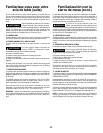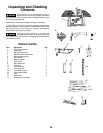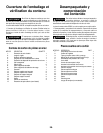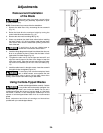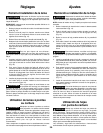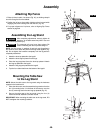
1
2
Removal and Installation
of the Blade
D
isconnect plug from power source before
performing any assembly, adjustment or repair
to avoid possible injury.
NOTE: Clean blade of any excess oil before installation.
1
. Remove the table insert
1 b
y unscrewing the two screws
2
(Fig. 14).
2. Raise the blade
3 to the maximum height by turning the
control wheel
4 counterclockwise (Fig. 15).
3. Remove the arbor nut
5 and flange 6 (Fig. 16).
4. Clean any sawdust from both blade collars before installing
the blade. Install a 10" (25.4 cm) blade. Install the saw blade
onto the the arbor with the blade teeth pointing toward the
front of the saw.
To avoid injury, do not use a blade larger or
smaller than 10
" diameter and 5/8" arbor.
5. Install the flange
6 against the blade 3 and thread the arbor nut
5 as far as possible by hand. Ensure that the blade is flush
against the inner blade flange (Fig. 16).
6. To tighten the arbor nut
5, use the open-end wrench 7 and
align the wrench jaws on the flats of the flange to keep the
arbor from turning. Place the box-end wrench
8 on the arbor
nut
5 and turn clockwise (to the rear of the saw table) (Fig.
17).
7. Install the table insert
1 in the table recess. Insert the screws 2
through the holes and tighten (Figure 14).
To avoid injury from a thrown workpiece, blade
part, or blade contact, never operate the saw
without the proper insert in place. Use the table insert when
sawing. Use the dado insert when using a dado blade.
Using Carbide-Tipped Blades
Handle carbide-tipped blades carefully. Carbide
is very brittle and can be easily damaged. Use
caution when you install, use or store the blades. Do not use a
carbide-tipped blade that is bent or has bent teeth, or if the blade
has cracks, is broken, or has missing/loose carbide tips. Do not
operate a carbide-tipped blade faster than its recommended
speed.
Read, understand and follow all warnings and instructions
provided with your carbide-tipped blades.
Adjustments
FIG. 14
8
7
5
6
5
FIG. 16
FIG. 17
WARNING
!
WARNING
!
WARNING
!
WARNING
!
4
3
FIG. 15
34.




